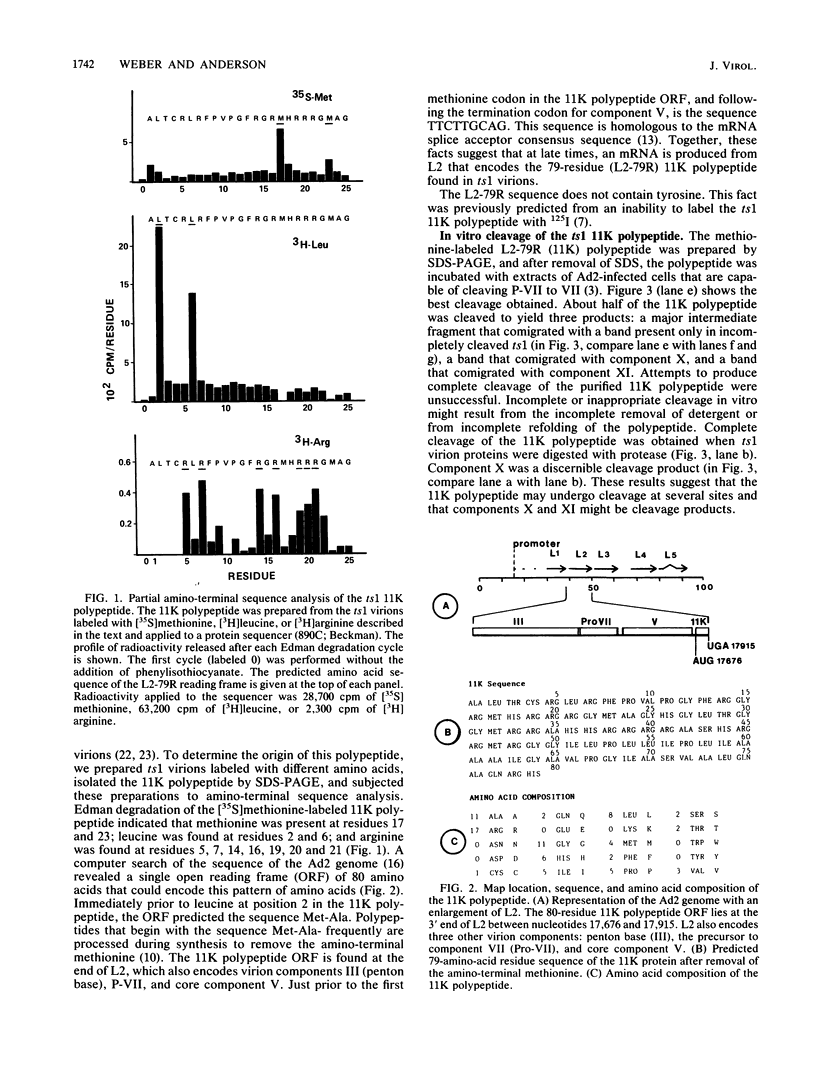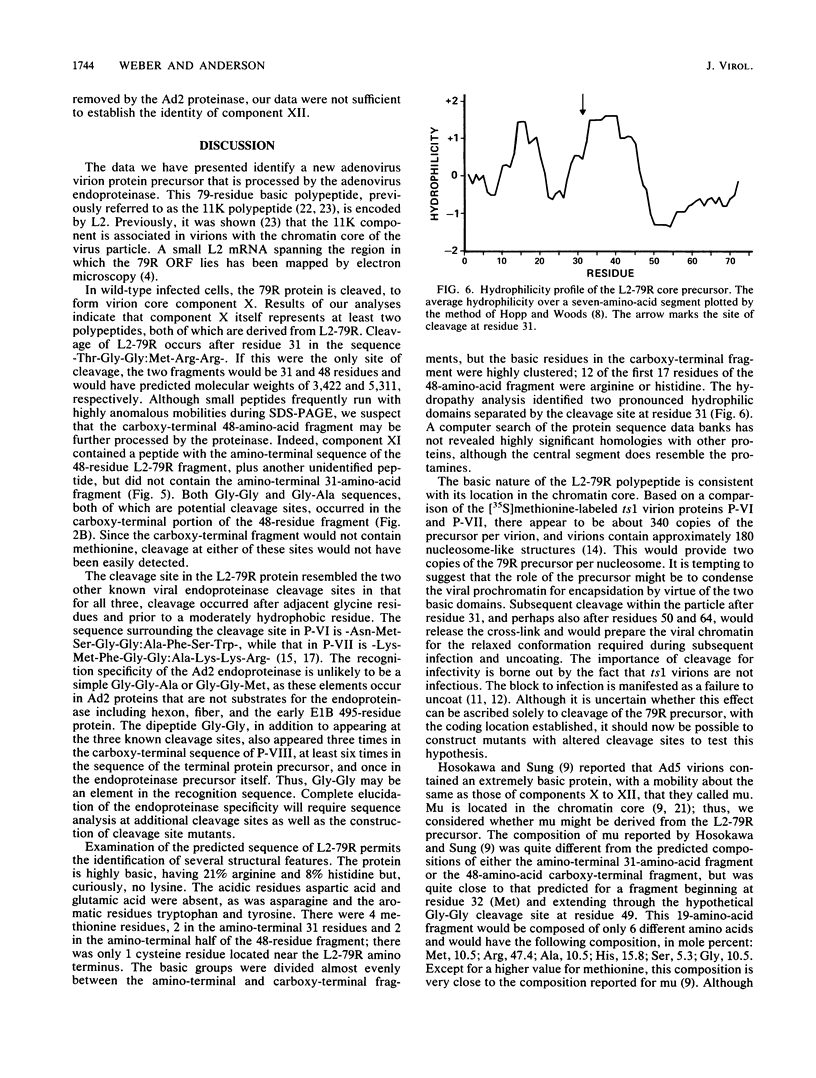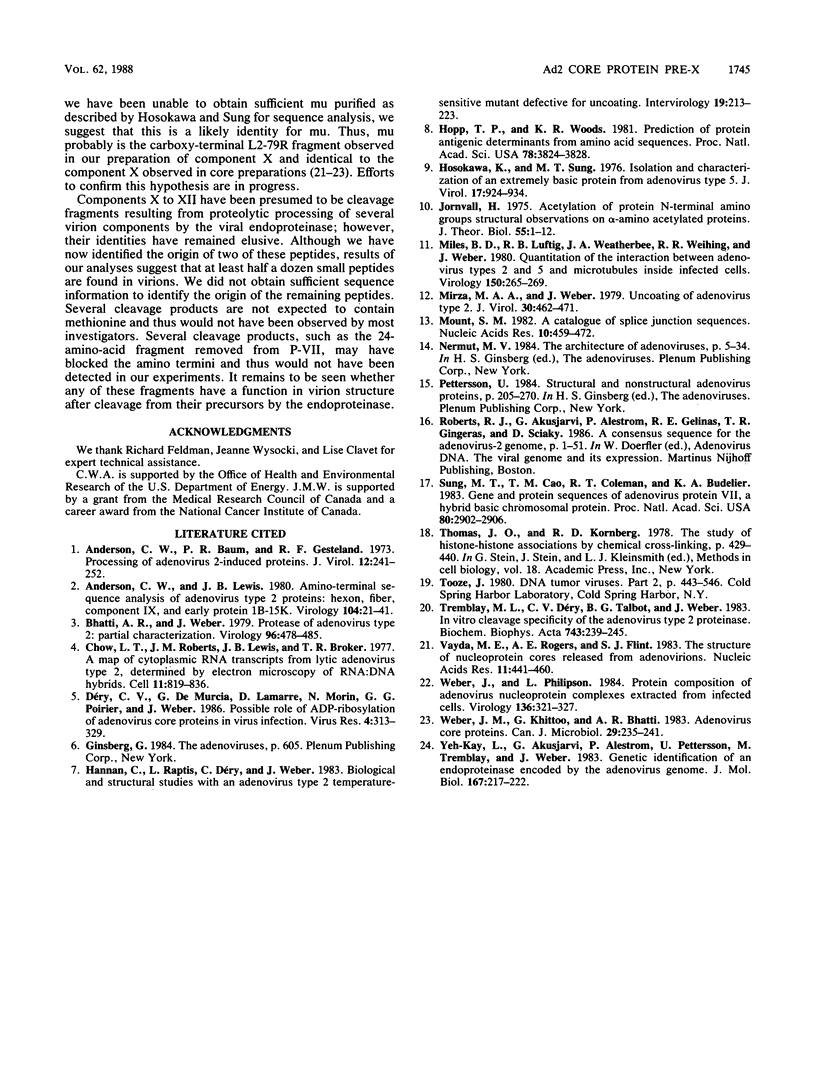Abstract
Nucleoprotein complexes extracted from infected cells (J. Weber and L. Philipson, Virology 136:321-327, 1984) or ts1 virions grown at 39 degrees C (J. M. Weber, G. Khitto, and A. R. Bhatti, Can. J. Microbiol. 29:235-241, 1983) contain, in addition to known virion proteins, a polypeptide with a molecular weight of 11,000 (11K polypeptide). We identified the gene for this polypeptide by sequence analysis of the radioactively labeled 11K polypeptide isolated from ts1 virions and comparison of this sequence with the nucleotide sequence of the adenovirus type 2 genome. The 11K polypeptide was encoded by an open reading frame of 80 residues located between nucleotides 17,676 and 17,915 in late transcription region 2 of adenovirus type 2; the initiating methionine residue was removed leaving a 79-residue product. The late transcription region 2 that encoded the 79-residue polypeptide (11K) was arginine rich (21%) and had a predicted molecular weight of 8,715. It was cleaved by the viral endoprotease to give two products which comigrated on sodium dodecyl sulfate-polyacrylamide gels as virion polypeptide X. Our data suggest that additional cleavage of the carboxy-terminal 48-residue fragment generates a 19-amino-acid fragment with the amino acid composition of mu (K. Hosokawa and M. T. Sung, J. Virol. 17:924-934, 1976).
Full text
PDF




Images in this article
Selected References
These references are in PubMed. This may not be the complete list of references from this article.
- Anderson C. W., Baum P. R., Gesteland R. F. Processing of adenovirus 2-induced proteins. J Virol. 1973 Aug;12(2):241–252. doi: 10.1128/jvi.12.2.241-252.1973. [DOI] [PMC free article] [PubMed] [Google Scholar]
- Anderson C. W., Lewis J. B. Amino-terminal sequence of adenovirus type 2 proteins: hexon, fiber, component IX, and early protein 1B-15K. Virology. 1980 Jul 15;104(1):27–41. doi: 10.1016/0042-6822(80)90363-3. [DOI] [PubMed] [Google Scholar]
- Bhatti A. R., Weber J. Protease of adenovirus type 2: partial characterization. Virology. 1979 Jul 30;96(2):478–485. doi: 10.1016/0042-6822(79)90105-3. [DOI] [PubMed] [Google Scholar]
- Chow L. T., Roberts J. M., Lewis J. B., Broker T. R. A map of cytoplasmic RNA transcripts from lytic adenovirus type 2, determined by electron microscopy of RNA:DNA hybrids. Cell. 1977 Aug;11(4):819–836. doi: 10.1016/0092-8674(77)90294-x. [DOI] [PubMed] [Google Scholar]
- Déry C. V., de Murcia G., Lamarre D., Morin N., Poirier G. G., Weber J. Possible role of ADP-ribosylation of adenovirus core proteins in virus infection. Virus Res. 1986 Jun;4(4):313–329. doi: 10.1016/0168-1702(86)90078-x. [DOI] [PubMed] [Google Scholar]
- Hannan C., Raptis L. H., Déry C. V., Weber J. Biological and structural studies with an adenovirus type 2 temperature-sensitive mutant defective for uncoating. Intervirology. 1983;19(4):213–223. doi: 10.1159/000149363. [DOI] [PubMed] [Google Scholar]
- Hopp T. P., Woods K. R. Prediction of protein antigenic determinants from amino acid sequences. Proc Natl Acad Sci U S A. 1981 Jun;78(6):3824–3828. doi: 10.1073/pnas.78.6.3824. [DOI] [PMC free article] [PubMed] [Google Scholar]
- Hosokawa K., Sung M. T. Isolation and characterization of an extremely basic protein from adenovirus type 5. J Virol. 1976 Mar;17(3):924–934. doi: 10.1128/jvi.17.3.924-934.1976. [DOI] [PMC free article] [PubMed] [Google Scholar]
- Jörnvall H. Acetylation of Protein N-terminal amino groups structural observations on alpha-amino acetylated proteins. J Theor Biol. 1975 Nov;55(1):1–12. doi: 10.1016/s0022-5193(75)80105-6. [DOI] [PubMed] [Google Scholar]
- Miles B. D., Luftig R. B., Weatherbee J. A., Weihing R. R., Weber J. Quantitation of the interaction between adenovirus types 2 and 5 and microtubules inside infected cells. Virology. 1980 Aug;105(1):265–269. doi: 10.1016/0042-6822(80)90177-4. [DOI] [PubMed] [Google Scholar]
- Mirza M. A., Weber J. Uncoating of adenovirus type 2. J Virol. 1979 May;30(2):462–471. doi: 10.1128/jvi.30.2.462-471.1979. [DOI] [PMC free article] [PubMed] [Google Scholar]
- Mount S. M. A catalogue of splice junction sequences. Nucleic Acids Res. 1982 Jan 22;10(2):459–472. doi: 10.1093/nar/10.2.459. [DOI] [PMC free article] [PubMed] [Google Scholar]
- Sung M. T., Cao T. M., Coleman R. T., Budelier K. A. Gene and protein sequences of adenovirus protein VII, a hybrid basic chromosomal protein. Proc Natl Acad Sci U S A. 1983 May;80(10):2902–2906. doi: 10.1073/pnas.80.10.2902. [DOI] [PMC free article] [PubMed] [Google Scholar]
- Thomas J. O., Kornberg R. D. The study of histone--histone associations by chemical cross-linking. Methods Cell Biol. 1978;18:429–440. [PubMed] [Google Scholar]
- Tremblay M. L., Déry C. V., Talbot B. G., Weber J. In vitro cleavage specificity of the adenovirus type 2 proteinase. Biochim Biophys Acta. 1983 Mar 16;743(2):239–245. doi: 10.1016/0167-4838(83)90220-0. [DOI] [PubMed] [Google Scholar]
- Vayda M. E., Rogers A. E., Flint S. J. The structure of nucleoprotein cores released from adenovirions. Nucleic Acids Res. 1983 Jan 25;11(2):441–460. doi: 10.1093/nar/11.2.441. [DOI] [PMC free article] [PubMed] [Google Scholar]
- Weber J. M., Khittoo G., Bhatti A. R. Adenovirus core proteins. Can J Microbiol. 1983 Feb;29(2):235–241. doi: 10.1139/m83-039. [DOI] [PubMed] [Google Scholar]
- Weber J., Philipson L. Protein composition of adenovirus nucleoprotein complexes extracted from infected cells. Virology. 1984 Jul 30;136(2):321–327. doi: 10.1016/0042-6822(84)90168-5. [DOI] [PubMed] [Google Scholar]
- Yeh-Kai L., Akusjärvi G., Aleström P., Pettersson U., Tremblay M., Weber J. Genetic identification of an endoproteinase encoded by the adenovirus genome. J Mol Biol. 1983 Jun 15;167(1):217–222. doi: 10.1016/s0022-2836(83)80044-8. [DOI] [PubMed] [Google Scholar]



